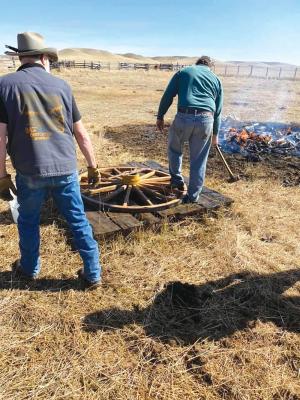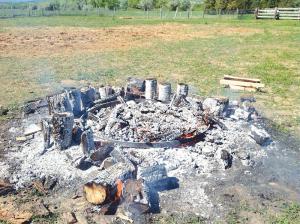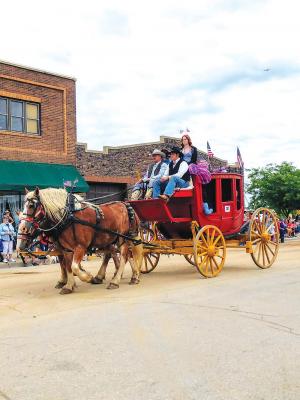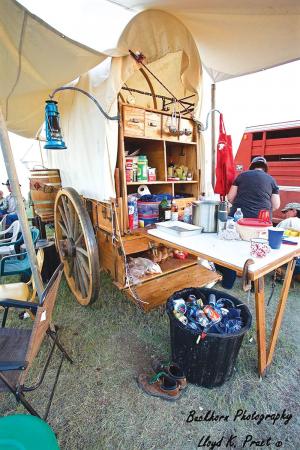2021 - Volume #45, Issue #5, Page #03
[ Sample Stories From This Issue | List of All Stories In This Issue | Print this story
| Read this issue]
Built-From-Scratch Chuck Wagon, Stagecoach
 |
 |
 |
 |
“I didn’t have the money to buy lumber when I was building the stagecoach or the chuck wagon, so I built a small electric sawmill,” recalls Thompson. “The 3-hp. electric motor is really too small, but as long as I keep the blade sharp, it can handle anything that fits the 20-in. throat.”
The sawmill made it possible to cut up some ash and oak trees growing on Thompson’s property. After drying the lumber in a kiln that he also made, he used it for everything from wheel spokes to framing and the reach that connected the front and back axles.
He also made any iron work fittings needed for the stagecoach. To do that, he had to make a forge.
“A friend gave me 4 or 5 boxes of insulated fire brick,” says Thompson. “I built a metal frame around them and installed pipe blowers after I flared the ends. The propane is delivered via 1/8-in. pipes and tees off to the blowers. I tapped MIG welding tips on the teed pipes. The tips create a Venturi effect to draw air into the flame.”
Working the iron required hammering, so he built a treadle hammer to punch holes using garage door springs.
About the only things he didn’t build for the stagecoach were the wagon hubs. In fact, that’s what he started with.
“I knew I could never justify the cost of a stagecoach, so I would have to build one if I wanted it,” says Thompson. “I had a book on how to build one, and a friend of mine gave me an old freight wagon, but the hubs were the only thing that were still good.”
Thompson first built the undercarriage and then built the wheels using oak and ash for the spokes. He cut out rectangular stock, angled it and then rounded the edge and put tenons in.
“The angles for spokes in the rear hubs were set for 52-in. wheels, but I was making 60-in. rear wheels, so the angles were wrong for the dish I needed,” says Thompson. “I didn’t get the tambor quite right either. It was a learning experience, and I have since been slowly redoing things that weren’t quite right.”
Rims were made with a bender he put together. They were heated in a wood fire to expand enough to seal to the wooden wheels when they cooled.
Thompson used old baler belting for the support straps that the full-size Concord style coach ride on. Rather than springs, the old coaches were built to sway, taking the bounce off for people and taking the jar off the horse’s shoulders.
Thompson bought canvas for the seat and some plywood for side panels of the coach. Roof panels were repurposed from bookcases that were being thrown out at the state college where Thompson does database programming.
“I don’t have a boot for the rear as yet,” he says. “I have a stack of deer hides I plan to tan and will make one then.”
Thompson credits a book he found on wheelwrighting and YouTube videos on the subject posted by Engle’s Coach Shop, Joliet, Mont. However, the wheels were still the biggest challenge of the entire project.
“Getting the angles of the spokes right is mind-boggling,” says Thompson. It would have been easier if I had made my own hubs instead of using the old ones.”
Thompson’s coach seats 6, and he finds plenty of excuses to fill them. “People ask me to give rides at weddings,” he says. “I also try to get it into our Fourth of July parade.”
The chuck wagon was as easy as the stagecoach was challenging. It started with his cousin giving him an old wagon with the original bent bows for canvas. Thompson measured the wagon and built accordingly.
“I bought 1-in. red oak boards to build the chuck box that sits at the rear of the wagon,” says Thompson. “It has an upper unit with shelves and drawers. The back door is hinged to lay down for use as a worktable. The lower box is where my Dutch ovens sit, and I have water barrels on either side.”
The full unit is 36 1/2-in. wide and 45 1/2-in. high. The upper box with shelves and drawers and the drop-down door is 25-in. deep and set back over the lower box. It is the same width, but 30-in. deep.
Thompson also built a firebox he can set grills on or hang coffee pots over. He did all the iron work on it, as well as anything else needed.
“I did some fancy forge work on the box, including my cousin’s brand and some fancy metal twists,” says Thompson.
Like the stagecoach, the chuckwagon finds plenty of uses, including the family’s annual branding.
“We set up camp about 5 miles out and cook food for about 50 people for the day,” he says. “My wife and daughter help, and we have half a dozen Dutch ovens going. It is a lot of fun, but also a lot of work.”
Contact: FARM SHOW Followup, Ven Thompson, 19109 Gaver Rd., Belle Fourche, S. Dak. 57717 (ph 605 210-1755; ven.thompson@bhsu.edu).

Click here to download page story appeared in.

Click here to read entire issue
To read the rest of this story, download this issue below or click here to register with your account number.




